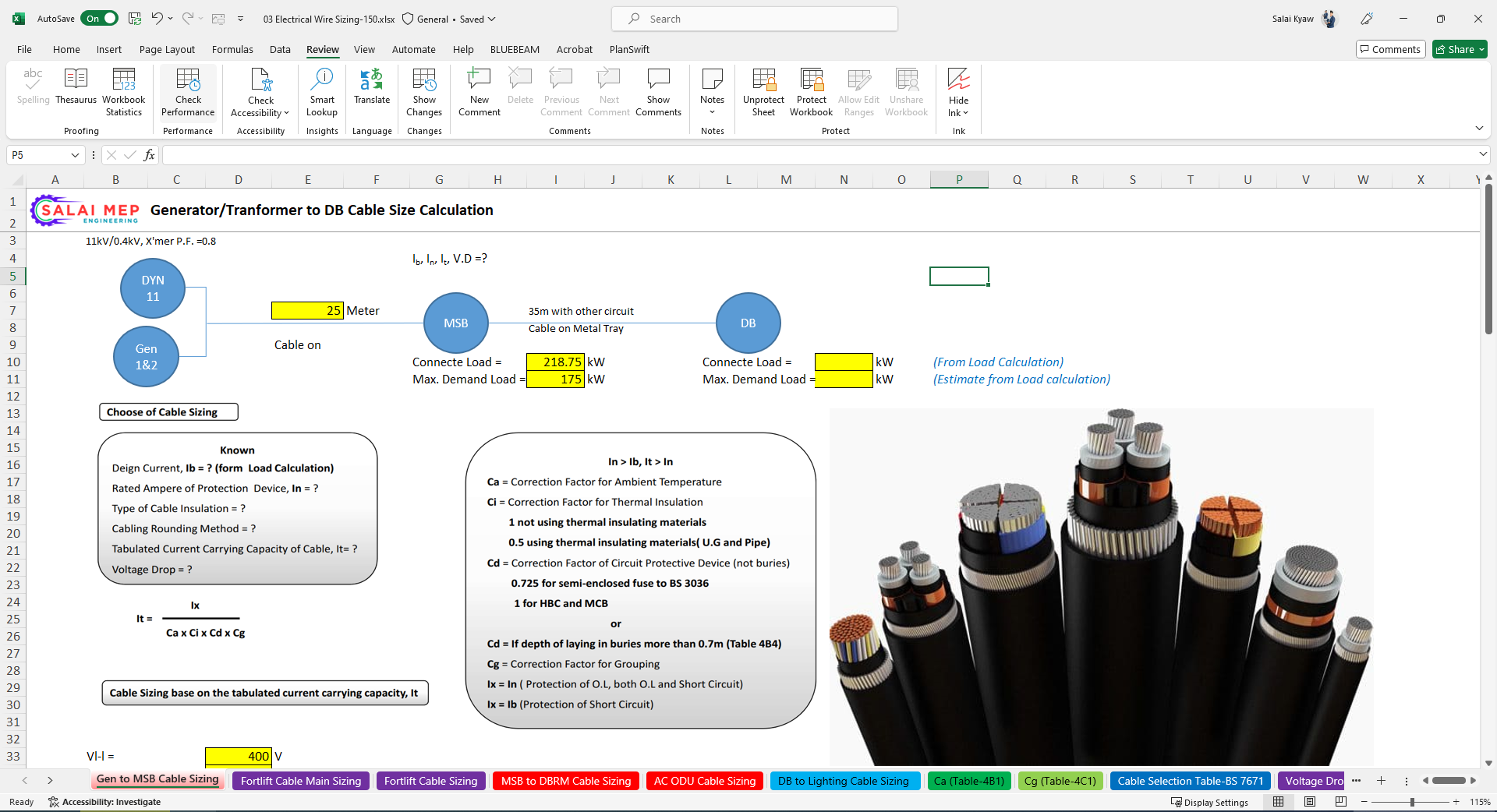Cable Size Calculation according to BS 7671 (the British Standard for electrical wiring regulations, also known as the IET Wiring Regulations) involves several steps to ensure safety, efficiency, and compliance with the regulations. Here’s a comprehensive guide and calculation.
Steps for Cable Size Calculation According to BS 7671
- Determine the Design Current (Ib):
- Calculate the current that the cable will carry.
- For single-phase circuits:𝐼𝑏=𝑃𝑉×cos𝜙Ib=V×cosϕP
- For three-phase circuits:𝐼𝑏=𝑃3×𝑉×cos𝜙Ib=3×V×cosϕP
- Where 𝑃P is the power in watts, 𝑉V is the voltage, and cos𝜙cosϕ is the power factor.
- Select the Protective Device Rating (In):
- Choose a protective device (circuit breaker or fuse) with a rating equal to or just above the design current 𝐼𝑏Ib.
- Determine the Required Cable Current-Carrying Capacity (It):
- According to BS 7671, the cable’s current-carrying capacity must be equal to or greater than the design current.
- It is adjusted for various factors:𝐼𝑡=𝐼𝑏𝑘1×𝑘2×𝑘3×⋯It=k1×k2×k3×⋯Ib
- Where 𝑘1,𝑘2,𝑘3,…k1,k2,k3,… are correction factors for temperature, grouping, thermal insulation, and other environmental factors.
- Select the Cable Type and Installation Method:
- Determine the type of cable (e.g., PVC, XLPE) and installation method (e.g., clipped direct, buried in the ground, in conduit).
- Use BS 7671 Tables to Find the Cable Size:
- Use the tables provided in BS 7671 to find the cable size that matches or exceeds the required current-carrying capacity 𝐼𝑡It.
- Reference the appropriate table based on the cable type, installation method, and correction factors.
- Check for Voltage Drop:
- Ensure the voltage drop within the circuit does not exceed the maximum permissible limits (typically 3% for lighting and 5% for other uses).
- For single-phase circuits:Δ𝑉=𝐼𝑏×𝐿×𝑚𝑉1000ΔV=1000Ib×L×mV
- For three-phase circuits:Δ𝑉=𝐼𝑏×𝐿×𝑚𝑉×31000ΔV=1000Ib×L×mV×3
- Where 𝐿L is the length of the cable run, and 𝑚𝑉mV is the voltage drop per meter per ampere.
7. Check for Short Circuit Conditions:
Verify that the cable can withstand the prospective short-circuit current for the required duration without damage.

Example Calculation
Let’s go through an example for a single-phase circuit.
Inputs:
- Load power: 7200W
- Voltage: 230V
- Power factor (cos𝜙cosϕ): 0.95
- Length of cable run: 50m
- Installation method: Clipped direct
- Ambient temperature: 30°C
- Protective device rating: 40A
Steps:
- Calculate Design Current (Ib):𝐼𝑏=7200𝑊230𝑉×0.95≈32.93𝐴Ib=230V×0.957200W≈32.93A
- Select Protective Device (In):
- Choose a 40A circuit breaker (next standard size above 32.93A).
- Determine Required Cable Capacity (It):
- Assume correction factors: temperature factor 𝑘1=0.97k1=0.97 (from BS 7671 for 30°C), no grouping factor 𝑘2k2, no insulation factor 𝑘3k3.
- Calculate 𝐼𝑡It:𝐼𝑡=32.93𝐴0.97×1×1≈33.96𝐴It=0.97×1×132.93A≈33.96A
- Select Cable Type and Installation Method:
- Assume PVC-insulated cable, clipped direct installation.
- Use BS 7671 Tables:
- From BS 7671 tables, a 6mm² PVC cable clipped direct has a current-carrying capacity of 38A (Table 4D5).
- Check for Voltage Drop:
- Voltage drop for 6mm² PVC cable clipped direct is approximately 7.3 mV/A/m.
- Calculate voltage drop:Δ𝑉=32.93𝐴×50𝑚×7.3𝑚𝑉1000≈12.02𝑉ΔV=100032.93A×50m×7.3mV≈12.02V
- Percentage voltage drop:Percentage Drop=12.02𝑉230𝑉×100≈5.22%Percentage Drop=230V12.02V×100≈5.22%
- Since 5.22% exceeds the typical 5% limit for general use, consider using a larger cable size to reduce the voltage drop.
- Check for Short Circuit Conditions:
- Verify using manufacturer’s data or BS 7671 guidelines that the selected cable can withstand the prospective short-circuit current.
Conclusion
By following these steps, you can accurately calculate the appropriate cable size according to BS 7671. This ensures that your electrical installations are safe, efficient, and compliant with regulatory standards. Always double-check your calculations and consider consulting with a professional engineer for complex systems.
Note: All Password are [“salaimep” or “salaimep.com”]
Download |OneDrive
Also Download – Circuit Breaker Calculation Excel & Lighting Design Calculation Excel










Thanks for your sharing.
My Pleasure…bro
Can you please share the excel copy
You can download for free…linke in the description
Dear Sir , Please share the password
Password is in the description